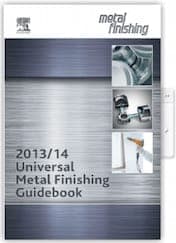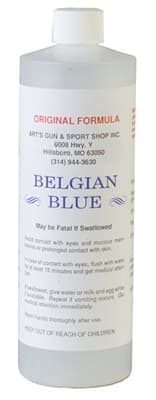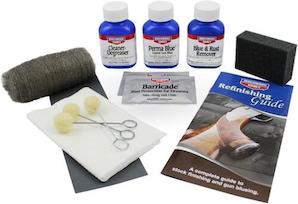
Curated with aloha by
Ted Mooney, P.E. RET

The authoritative public forum
for Metal Finishing 1989-2025

-----
Formula for cold blackening / cold bluing / cold black oxide
Quickstart:
People study chemistry in school, and then naturally assume that the way surface finishing is done is by mixing raw commodity chemicals per their school lessons and coming up with their own process solutions. But just as people buy shotguns rather than building their own, people in most of the world these days buy well-developed proprietary processes rather than starting the development process over for themselves, especially for cold blackening in lieu of hot bluing.
Q. Hi
I want to blue (blacken) hunting shotgun barrels -- Cold or Hot can I be given a formula for this?
- LATSIA NICOSIA CYPRUS
April 19, 2019
A. Hi Antonis. Goran offers 3 cold-bluing formulas on the page you are viewing.
In addition to this cold bluing thread, we also have many other threads about blackening -- thread 11740, "Black oxide formula for Hot Blueing of Guns/Firearms" should help you with the hot black oxide formulas. But note that there is more to hot bluing than the formula, and that it is very dangerous due to the risk of this hot solution erupting (water instantly flashing to steam); use hot black oxide only with training, full protective equipment, and in a proper industrial setting. Good luck!
Regards,

Ted Mooney, P.E. RET
Striving to live Aloha
finishing.com - Pine Beach, New Jersey
Q. Hello, can anyone help me to create a black oxide solution that will do the same as [name deleted for a lot of reasons including that the vendor requested it :-)]
I have a product that I have to mass produce, and the named product is coming out too expensive.
Reading the label it's comprised of selenious acid and phosphoric acids.
Making selenic acid will be tricky, and I would like to know the raw products to use. Apparently you put selenium into nitric acid.
So if anyone can help with this and or the recipe for the solution, that would be a godsend.
Thank you in advance,
John
- Geelong, vic, Australia
May 27, 2020
A. Hi John. We appended your inquiry to a thread which offers generic formulations for cold blackening solutions. Good luck with them!
Also, there are vendors who sell in quantity, presumably at lower prices if you want to consider that option. Patents are public info and very easy to access these days :-)
Regards,

Ted Mooney, P.E. RET
Striving to live Aloha
finishing.com - Pine Beach, New Jersey
Multiple threads merged: please forgive chronology errors and repetition 🙂
Q. Hi I found this recipe on this forum and am using to blue steel which will be clear powdercoated for decorative use, could you please help me with the best method to combine these ingredients?
"copper sulphate10%
Selenious Acid 6%
Nitric Acid 5%
Demineralised Water 79%"
Thank you,
- Invercargill Southland
September 12, 2020
A. Hi Shayle. I have no experience with the best sequence for mixing those ingredients, but do have two comments. First, I'm not confident that good adhesion of the clearcoat is assured, because these formulations do tend to be quite smutty. Second, if you're going for blue, you might need highly polished metal; I believe that many blackening treatments tend to look a dark jewel blue color on highly polished metal but more of a matte black on rougher surfaces.
Luck & Regards,

Ted Mooney, P.E. RET
Striving to live Aloha
finishing.com - Pine Beach, New Jersey
Q. Hi. I want to get some information about the blackening of carbon steel by cold process.
I am specifying carbon steel and cold process for blackening because I need this process for screwdriver rod which is chrome plated. If I use hot process for blackening then the fumes destroys the look of rod and causes difficulty in further finishing. So, in short....
1. I want to know about complete process for cold blackening.
2. To blacken the tip of rod.
3. The rod is made of carbon steel.
4. And the rod is chrome plated.
Thanking in anticipation.
Regards
A student
- Lahore Pakistan
September 29, 2020
A. Hi Abdullah. We appended your inquiry to a long thread about how to formulate and monitor home-brew cold bluing / cold blackening solutions.
But I don't think that's the heart of the problem. Rather, I think the question is whether cold blackening will suffice, and I don't think it will. I have seen and used these black-tipped screwdrivers, and although I haven't been involved in their finishing, I very seriously doubt that any high quality ones are cold blackened. I'm not even sure that they are hot black oxided, they might be black nickel or black chrome.
I don't think it would be a big deal to mask the shaft of chrome plated screwdrivers for subsequent processing -- a reusable PVC or silicone tube/straw with a centimeter of platers tape top and bottom seems like no big deal, and you have to mask near the tip regardless for a good demarcation line. Or you could do the black oxide tip first and mask it for the plating.
Luck & Regards,

Ted Mooney, P.E. RET
Striving to live Aloha
finishing.com - Pine Beach, New Jersey
Q. Hi there. Can anybody confirm me that the formula for cold blue/blackening given above by Goran i.e., "manganese nitrate + copper nitrate + water" works or not??
I was going to use formula which is based on selenic or selenious acid but they are not available in my country.
So, kindly help me in using this alternate formula.
Thanking in anticipation
Regards
- Lahore Pakistan
October 2, 2020
Q. Hi there again. I have used the formula for blackening given by Goran based on Manganese nitrate and copper nitrate.
Mn(NO3)2 50 gm
Cu(NO3)2 50 gm
Water 1 litre
Temp 50 °C
The whole procedure I have used for blackening is as follows:
1. first I cleaned the metal(carbon steel) with an acid and
dipped it into the water.
2. then I dipped it into the Bluing solution for 5-10 min.
3. lastly I dipped it into oil.
The results are also as follows:
1. it shows the matte black color.
2. the color removes off and makes hand dirtier.
3. sometimes copper becomes visible.
So, kindly tell me how can I:
1. decrease time span.
2. make it look more shiny and deep.
3. prevent it from rubbing off.
Thanks. It worked but not as well as I really wanted. I am facing a problem that is after bluing, copper coloured spots appear on the metal surface, which causes the surface to look badly treated or finished.
So, kindly help me how can I prevent copper from appearing on metal surface.
Thanking in anticipation.
- Lahore Pakistan
⇩ Related postings, oldest first ⇩
Q. I am interested in locating any available information on blackening processes for steel, stainless and brass. My preference would be for a cold process. Any help would be greatly appreciated!
D Vanek1995
A. Hi, D. You said "my preference", rather than "my requirement", so before talking about the formulation for room-temperature blackening, in fairness to you we should mention that it is generally less satisfactory than hot black oxide (but it is a lot safer). We have a quick Hot Black Oxide vs. Cold Blackening FAQ on line here.
The Metal Finishing Guidebook has a chapter with formulas for solutions for blackening and coloring metals. But better results will usually be obtained with proprietary blackening systems available from the suppliers listed in our directory or in the yellow pages.
For hobbyist level work, cold Gun Blue is readily available in small quantities. Good luck!

Ted Mooney, P.E.
Striving to live Aloha
finishing.com - Pine Beach, New Jersey
sometimes on
AbeBooks or Amazon
(affil links)

free pdf is currently available from academia.edu
Q. Want cold black coloring process for D2 steel?
Acid resistant, scratch resistant, hard enough . . .
1996
A. Hello, Sayid.
There are room temperature blackening solutions offered by EPI / Electrochemical Products Inc. [a finishing.com supporting advertiser], Birchwood Technologies [a finishing.com supporting advertiser], and others. You'll finder deeper coverage in the Metal Finishing Guidebook ⇨

Ted Mooney, P.E.
Striving to live Aloha
finishing.com - Pine Beach, New Jersey
Multiple threads merged: please forgive chronology errors and repetition 🙂
Q. I want to blacken iron at room temperature. Is there any way to do it? Also, what is the chemical to be used? I would be interested in making my own rather than buying it.
Rajiv Vyas- Hyderabad, Andhra Pradesh, India
2001
A. Hi, Mr. Yvas. Sorry that I don't know exact formulas, but some are in the MFG. People in the USA rarely make their own metal finishing chemicals anymore, so we tend to not have formulas in memory anymore; the people who know the formulations best are employed by the suppliers and can't reveal them.
However, as a start, I think room temperature blackening solutions are selenium and copper based. Searching patents or searching old journal articles from 20 or 30 years ago with surfacequery.com or scholar.google.com should be productive.
Personally, I find even the best room temperature blackening, developed over a period of decades, to not be the equal of hot black oxides. So I think your chances of developing your own room temperature blackening chemistry that you'll be fully satisfied with may be slim. But good luck.

Ted Mooney, P.E.
Striving to live Aloha
finishing.com - Pine Beach, New Jersey
A. Cold black for iron:
tannic acid
⇦ this on
eBay
or
Amazon [affil links] .......20 gm
tartaric acid
⇦ this on
eBay
or
Amazon [affil links] ......20 gm
water..............1 lit
Cold black II:
coper sulphate.......100 gm
selenic acid..........45 gm
nitric acid...........50 gm
water.................1 lit
- Zagreb,Croatia
2003
Excellent!
Maan saab- Haryana
December 19, 2022
Multiple threads merged: please forgive chronology errors and repetition 🙂
Q. Dear sir,
I want to blacken mild steel sheets. I mean to give them a black colour with copper and selenium based material at room temperature; please guide me in this regard. I want to do it for corrosion prevention as well as to beautify the material.
- Islamabad, Pakistan
2002
A. We have an FAQ about Black Oxide and Cold Blackening, Muhammad. The Metal Finishing Guidebook includes a very good treatment of this subject. Missing will be the exact formulations of modern cold blackening solutions, however, as this is the proprietary knowledge of the companies who have invested in the experimentation. Cold blackening offers no corrosion resistance, although the wax or oil you may finish it off with will help a bit. Good luck.

Ted Mooney, P.E.
Striving to live Aloha
finishing.com - Pine Beach, New Jersey
Q. Dear reader
We are a manufacturer of finishing products in India. Would like get help on :
1. Composition of cold blackening solution of Ferrous metal.
2. Process
Regards,
chemicals - Mumbai, India
2005
A. We have an FAQ about Black Oxide on line here as a quick intro. After that, you could consult the Metal Finishing Guidebook. Then do a lit search and expired patent search. Best of luck with it.

Ted Mooney, P.E.
Striving to live Aloha
finishing.com - Pine Beach, New Jersey
A. Dear Suraj!
You can use next solution:
6 gms selenic acid
10 gms copper sulphate
4-6 ml nitric acid(1,34 gm/cm3)
1 lit water
20-25 °C temp.
according to Detnner/Elze: Handbuch der Galvanotecnik,1966.
- Cerovski vrh Croatia
Multiple threads merged: please forgive chronology errors and repetition 🙂
Q. Can anyone please assist me with a better formulation and process for "Cold Bluing".
The one I currently have is as follows:
copper sulphate
⇦ this on
eBay or
Amazon [affil links] 10 %
Selenious Acid 6 %
Nitric Acid 5 %
Demineralised Water 79 %
I am an industrial chemist and am familiar with the hazards of metal finishing chemicals in particular. Regards
Bernie Swart
January 6, 2008
Industrial Chemist & Registered Gunsmith - Western cape, South Africa
A. Cold blue:
manganese nitrate...50 gm (up to 75gm)
copper nitrate
⇦ this on
eBay
or
Amazon [affil links]
.....50 gm
Water...............1 lit
50 °C temp.
Hope it helps and good luck!
- Cerovski vrh Croatia
A. Bernie
The formulation you have is about right for a "cold blue". As you would guess it gives a bluish finish of copper selenide. It is quick, easy, cheap and pretty useless for a working gun.
The durable finish you need comes from a molten caustic / nitrate bath. It is nasty, difficult, potentially dangerous and gives a superb finish.

Geoff Smith
Hampshire, England
Multiple threads merged: please forgive chronology errors and repetition 🙂
Q. I shall be highly thankful if someone could be given me a guideline for the following: I want to know which compound is used as a surface conditioner / surface activation before Room temperature cold blackening process. It activates the iron surfaces and promotes the formation of uniform, dense and black coating.
Rajkumar ShahMetal Treatment Chemicals - SURAT, Gujarat State, India
January 28, 2012
Analytical procedure for Selenium Copper blackening solution?Q. I'm looking for analytical procedures to test Se/Cu based darkening solutions. I have some ideas but some guidance would be most welcome. Birchwood Casey offers a 'send us a sample' but they are not specific about what they do. I like to do it myself.  Dave Wichern Consultant - The Bronx, New York February 22, 2017 Ed. note: Blackening of copper is a different topic than cold blackening of steel, but since we're talking about analysis for selenium, the procedures may have enough overlap that this helps the people who are cold blackening steel :-) Q. Hi Sir, Chemical Engineer - Alexandria, Egypt A. I think the reactions are as follows:  Dave Wichern Consultant - The Bronx, New York |
Q, A, or Comment on THIS thread -or- Start a NEW Thread


